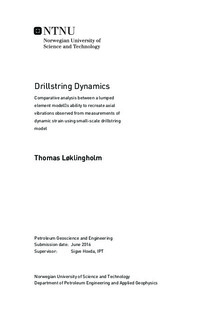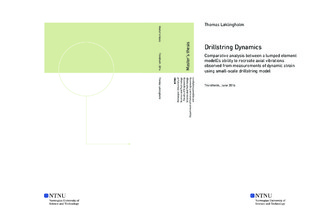| dc.contributor.advisor | Hovda, Sigve | |
| dc.contributor.author | Løklingholm, Thomas | |
| dc.date.accessioned | 2016-09-16T14:00:47Z | |
| dc.date.available | 2016-09-16T14:00:47Z | |
| dc.date.created | 2016-06-10 | |
| dc.date.issued | 2016 | |
| dc.identifier | ntnudaim:15029 | |
| dc.identifier.uri | http://hdl.handle.net/11250/2407894 | |
| dc.description.abstract | Lumped element models are desirable for their mathematical simplicity and their practical application for simulating axial vibrations. These models however only approximate the dynamic behavior, and is why real time measurements are essential for validating these analytical models. This is why a small-scale physical model of a drillstring was used for validating the axial vibrations simulated by the analytical model. These axial vibrations from the model were measured using strain gauges, where the vibrations where indicated by dynamic strain measurements. These measured results of axial vibrations showed that there were clear differences between theoretical and measured data. This thesis presents the results discovered and the comparison between the simulated vibrations from the lumped element model, and the measured axial vibrations produced from the small-scale drillstring model. These existing differences are discussed and evaluated, and suggestions and arguments are proposed to explain the causality behind the difference observed between analytical model and the measured axial vibrations. | |
| dc.language | eng | |
| dc.publisher | NTNU | |
| dc.subject | Petroleumsfag, Boreteknologi | |
| dc.title | Drillstring Dynamics - Comparative analysis between a lumped element model s ability to recreate axial vibrations observed from measurements of dynamic strain using small-scale drillstring model | |
| dc.type | Master thesis | |
| dc.source.pagenumber | 115 | |

